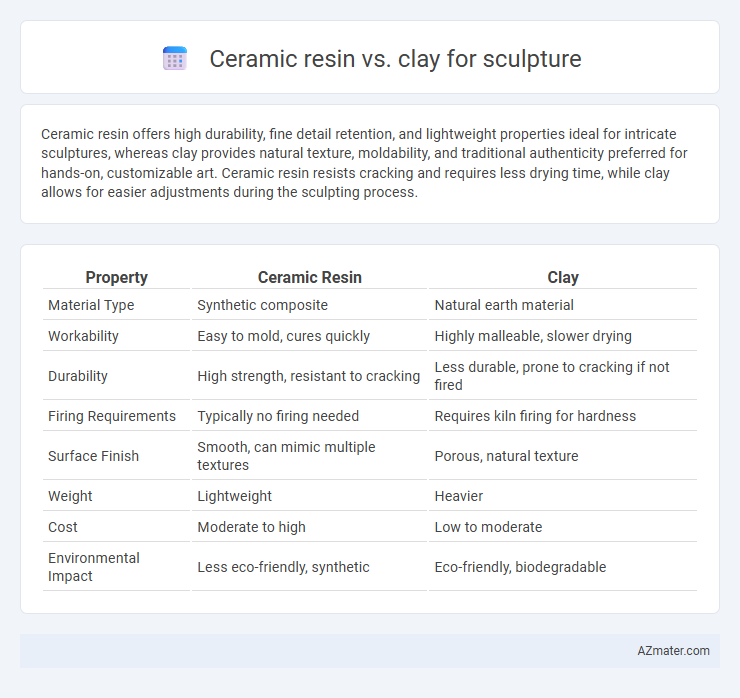Ceramic resin offers high durability, fine detail retention, and lightweight properties ideal for intricate sculptures, whereas clay provides natural texture, moldability, and traditional authenticity preferred for hands-on, customizable art. Ceramic resin resists cracking and requires less drying time, while clay allows for easier adjustments during the sculpting process.
Table of Comparison
| Property | Ceramic Resin | Clay |
|---|---|---|
| Material Type | Synthetic composite | Natural earth material |
| Workability | Easy to mold, cures quickly | Highly malleable, slower drying |
| Durability | High strength, resistant to cracking | Less durable, prone to cracking if not fired |
| Firing Requirements | Typically no firing needed | Requires kiln firing for hardness |
| Surface Finish | Smooth, can mimic multiple textures | Porous, natural texture |
| Weight | Lightweight | Heavier |
| Cost | Moderate to high | Low to moderate |
| Environmental Impact | Less eco-friendly, synthetic | Eco-friendly, biodegradable |
Introduction to Ceramic Resin and Clay
Ceramic resin is a synthetic material combining fine ceramic powders and polymer resins, offering durability and versatility for detailed sculpture work. Clay, a natural earth material composed of fine mineral particles, has been a traditional medium known for its plasticity and ease of shaping. Both materials provide unique textural qualities and finishing potentials, with ceramic resin allowing for sharper details and clay enabling organic, malleable forms.
Material Composition and Properties
Ceramic resin, composed primarily of polymer resin mixed with ceramic particles, offers a lightweight yet durable material with high tensile strength and excellent detail retention for intricate sculptures. Clay, a natural earthy material composed of fine-grained minerals such as kaolinite, provides plasticity and malleability, allowing for easy shaping but requires firing in a kiln to achieve hardness and durability. While ceramic resin cures at room temperature and resists cracking, clay sculptures become more porous and fragile unless glazed or properly fired.
Workability and Sculpting Techniques
Ceramic resin offers superior workability with its smooth, consistent texture that allows for fine detail and intricate sculpting techniques such as carving, molding, and casting, ideal for precision work. In contrast, clay provides a more tactile experience with a softer, malleable consistency that supports hand-building methods like coiling, pinching, and slab construction, promoting flexibility in form adjustments. While ceramic resin cures quickly and retains sharp details, clay requires consistent moisture management and longer drying times, affecting workflow and sculpting approach.
Durability and Longevity
Ceramic resin offers superior durability and longevity compared to clay due to its resistance to cracking, chipping, and environmental factors like moisture and temperature fluctuations. Unlike clay, which can degrade over time and often requires sealing or firing to harden, ceramic resin maintains structural integrity without extensive maintenance. This makes ceramic resin an ideal choice for outdoor sculptures or pieces exposed to varying conditions.
Surface Finishes and Textural Effects
Ceramic resin offers a smooth, consistent surface finish ideal for detailed, refined textures that highlight intricate designs, while clay provides a naturally rougher, more organic texture allowing for expressive and tactile effects. Resin's non-porous nature enables vibrant paint applications and glossy finishes, enhancing visual depth, whereas clay's porous surface absorbs glazes, creating varied matte or satin finishes with a handcrafted feel. Artists seeking precise surface refinement prefer ceramic resin, while those prioritizing natural texture and varied finishes favor clay for its versatile, dynamic qualities.
Curing, Drying, and Firing Processes
Ceramic resin cures through a chemical reaction, typically requiring controlled temperature and humidity to achieve full hardness, whereas clay undergoes drying and firing processes that transform it from soft clay to a permanent ceramic form. Clay drying involves natural evaporation of water, which can cause cracking if done too quickly, followed by firing in a kiln at temperatures ranging from 1,000degC to 1,300degC to vitrify and strengthen the sculpture. Resin curing is faster and less prone to shrinkage or warping, but firing is not applicable, making clay preferred for high-heat and traditional ceramic finishes.
Artistic Applications and Use Cases
Ceramic resin offers superior durability and fine detail replication, making it ideal for intricate sculptures and mixed-media installations where precision and longevity are essential. Clay provides unparalleled malleability and tactile feedback, favored by artists for modeling expressive, textured forms and iterative design processes in both traditional and contemporary sculpture. Resin suits permanent, outdoor displays and complex casting, while clay excels in live sculpting, experimentation, and pieces requiring post-firing refinement.
Cost Comparison and Accessibility
Ceramic resin sculptures generally incur higher initial costs due to expensive raw materials and the need for specialized equipment like kilns, whereas clay is more budget-friendly and widely accessible for artists of all levels. Ceramic resin offers faster curing times and durability but often requires purchase from specialty suppliers, limiting immediate availability compared to clay, which is readily found in art stores and educational settings. The long-term investment in ceramic resin can be higher, while clay remains the preferred material for cost-effective experimentation and local accessibility.
Environmental Impact and Safety
Ceramic resin offers a lower environmental footprint by requiring less energy during curing compared to the high-temperature firing process of clay sculptures. Unlike clay, which emits dust that can pose respiratory hazards during handling and firing, ceramic resin materials typically produce fewer airborne particles, enhancing safety for artists. Furthermore, many ceramic resins are formulated with eco-friendly, non-toxic compounds, reducing harmful chemical exposure and environmental contamination.
Choosing the Right Material for Your Sculpture
Ceramic resin offers durability, smooth finishes, and is ideal for fine details in modern sculptures, while clay provides unmatched versatility and ease of manipulation for both beginners and experienced artists. Selecting the right material depends on the desired texture, strength, and longevity of the piece, as well as the artist's workflow preferences. Understanding the specific properties of ceramic resin and clay ensures the final sculpture meets both aesthetic and functional goals.

Infographic: Ceramic resin vs Clay for Sculpture
 azmater.com
azmater.com